Changing Technology or Behavior? The Impacts of a Behavioral Disruption
Abstract
:1. Introduction
1.1. The Pivotal Role of the Transportation Sector in the Energy Transition
1.2. The Limits of the Current Solutions
- The quantification of the role of consumer behaviors in the energy transition needs to be further documented [5,6]. Historically, it was assumed that consumers had rational behaviors, so the role of consumers was not taken into account in the transition [7]. Recently, a lot of scientific approaches have been developed to quantify non-rational consumer behaviors and integrate them into models, either endogenously (in the form of behavioral variables) or exogenously (in the form of storylines) [8,9,10,11]. However, policies still often dissociate behavioral changes from the energy transition, focusing on the quantification of technological solutions [5,12]. In this sense, this study helps continue to document and quantify the role of transportation consumer behavior in decarbonization efforts.
- The concept of disruption should also be developed, as there is only a small amount of literature integrating this concept in models [13,14]. To date, only very few papers have integrated disruptions into their models, which propose solutions with linear transitions [15]. However, if global warming is to be limited to 1.5 °C above pre-industrial levels [3], the transition must be both rapid and of large scale. The greater the climate urgency, the more the concept of disruption can be used as a key tool of how the energy system could change [16]. This study aims to explore the concept of disruption and its role in the energy transition.
1.3. Research Objectives and Contributions
- The quantification of the consequences of a behavioral disruption in the transportation sector is a useful contribution to decarbonization models, as it opens up their possibilities.
- It is also an interesting way to “relax” model constraints while achieving the fixed GHG reduction targets.
2. Materials and Methods
2.1. Case Study
2.2. Model General Specifications
2.3. Environmental Impacts
2.4. Modeling the Private Transportation Sector
2.5. The Scenarios
2.5.1. Reference Case
- A carbon market is already in place in Quebec (with California) and represented in the model through a tax on carbon, representing the (minimum) carbon price on the market. The lowest price per ton of CO2eq is expected to increase by 5% per year (from CAD 10 per ton of CO2 in 2012 up to CAD 66 per ton in 2050) [38,39,41].
- A minimal number of electric vehicles is imposed in the transportation sector: a minimum of 6%, (i.e., 100,000 electric or hybrid vehicles in Quebec in 2020) and 20% in 2030 (i.e., 1,000,000 electric or hybrid vehicles in Quebec in 2030) [24]. This objective was adjusted in November 2020, increasing it to 1,500,000 electric vehicles [23].
- All gasoline vehicles run on a minimum of 5% ethanol and 2% biodiesel for diesel vehicles, a policy implemented in 2010 [39].
- Vehicle manufacturers must comply with the corporate fuel average economy (CAFE). Vehicles therefore have a minimum energy efficiency [28].
2.5.2. GHG Emissions Reduction (GHG80)
2.5.3. Massive Electrification (Electrification)
2.5.4. Behavioral Disruption Scenario: Carpooling Development
2.5.5. Carpooling Scenario Discussion
- A behavioral shift will be required in any case. While a behavioral shift is very hard to achieve, so is the deep decarbonization of the economy by 2050. Thinking that deep decarbonization can happen only with technology and no behavioral change is not credible. The cost of new technologies required to achieve decarbonization would itself require some behavioral change, as there are not enough resources to have carbon-free technologies without changing some consumption patterns, under our already debt-laden governments. Behaviors will have to change either because of severe climate change, because of financial restrictions due to the required investments, or because of pro-active policies to minimize the cost of decarbonization. In all cases, some hard-to-do behavioral changes will happen.
- The COVID-19 pandemic illustrated that drastic behavioral changes happen in crisis situations. The climate crisis could justify and potentially lead to some important behavioral shifts. It is better to plan these shifts than having individuals being constrained or forced to make them—under extreme climate or financial circumstances.
2.6. Sensitivity Analysis
2.6.1. Discount Rate Variations
2.6.2. Cars Lifetime Variations
3. Results and Discussion
3.1. Electric Vehicles Market Shares
3.1.1. Implementation of EVs without Additional Policy (Reference Scenario)
3.1.2. Optimal Response to a Reduction in GHG Emissions (GHG80 Scenario)
3.1.3. Impacts of a Transport Electrification Policy
3.1.4. Impact of a Behavioral Shift Scenario
3.2. Energy Supply and Demand
3.3. Environmental Impacts
3.4. The Cost of the Transition
3.5. Sensitivity Analysis
3.5.1. High Discount Rate
3.5.2. Cars Lifetime
4. Conclusions
- The potential limits of technological solutions (reduction of GHG emissions and massive electrification scenarios): If we want the scenarios to achieve 80% GHG emissions reduction in 2050, carbon capture and storage technologies must be available on the market. Moreover, even if the technological scenarios allow us to achieve the environmental objective of reducing GHG emissions by 80% in 2050, they require a high investment if we do not want to face physical limitations in electrical capacity. According to our model, scenarios that achieve our objectives through innovation alone will also increase costs to invest in the vehicle fleet and in new electricity infrastructure (about CAD 2 billion/year).
- The need to integrate behavioral policies into our current energy policies by quantifying the benefits that will result from “environmentally friendly” behavior: Whether for road users or the government, the savings associated with a simple carpooling scenario would be significant (reducing household transportation costs by about 50% and limiting the need of new power generation infrastructure). In addition, technological efforts would be reduced to achieve the same environmental results. Such a scenario would, therefore, offer more flexibility and allow a faster energy transition if properly associated with technological innovation. Finally, the behavioral disruption postpones the required increase in carbon price, which could be a significant factor given the sensitivity to high carbon prices of many voters.
- The responsibility of the regions in the transition: By starting with small-scale solutions, it will be easier for each territory to make its own transition and to transpose this solution to the national or even international level. In this respect, the NATEM model can be used at several levels and describe the constraint of each region individually.
- The energy transition is a multi-stakeholder transition: The behavioral disruption scenario shows us that scenarios that combine the strengths of different actors lead to more efficient results and assure more flexibility. The energy transition must be driven as much by politicians as by consumers or by the various economic actors.
- Behavioral shifts’ technicalities: It has been pointed out that the technological solutions considered today such as massive electrification can face some barriers that are not necessarily considered in the optimization. The same remarks apply to the behavioral disruption scenario as the difficulties of changing habits with carpooling are not considered other than in the sensitivity analysis. The psychological cost of changing to carpooling is not considered, and the psychological cost/social resistance to large electric investments is not integrated into the model either.
Supplementary Materials
Author Contributions
Funding
Institutional Review Board Statement
Informed Consent Statement
Conflicts of Interest
Appendix A
| Segmentation | Vehicle Class | Interior Volume (L) | Weight (kg) | Loading (pass/veh) | Distance Travelled (km/yr) | 2015 Demand (Mpass·km) |
|---|---|---|---|---|---|---|
| Small cars | Two-seater, mini-compact, subcompact, compact | 0–3115 | - | 1.57 | 15,524 | 52,091 |
| Large cars | Compact, midsize, full-size, station wagon | 3115–4530 | 1.57 | 15,838 | 45,747 | |
| Light trucks | Pickup truck, SUV, minivan, van | - | 2722–3856 | 1.69 | 20,401 | 45,524 |
| Small Cars | Insurance, Registration 1 (CAD) | Oil (CAD/km) | Brakes (CAD/km) | Tires (CAD/km) | Variables O&M 1 (CAD/km) |
|---|---|---|---|---|---|
| BEV | 750 | 0.000 | 0.004 | 0.019 | 0.023 |
| PHEV | 750 | 0.003 | 0.006 | 0.019 | 0.028 |
| FFV | 750 | 0.006 | 0.010 | 0.019 | 0.035 |
| Large Cars | Insurance, Registration 1 (CAD) | Oil (CAD/km) | Brakes (CAD/km) | Tires (CAD/km) | Variables O&M (CAD/km) |
|---|---|---|---|---|---|
| BEV | 1000 | 0.000 | 0.004 | 0.020 | 0.024 |
| PHEV | 1000 | 0.003 | 0.006 | 0.020 | 0.029 |
| FFV | 1000 | 0.006 | 0.010 | 0.020 | 0.036 |
| Light Trucks | Insurance, Registration 1 (CAD) | Oil (CAD/km) | Brakes (CAD/km) | Tires (CAD/km) | Variables O&M (CAD/km) |
|---|---|---|---|---|---|
| BEV | 1500 | 0.000 | 0.004 | 0.026 | 0.030 |
| PHEV | 1500 | 0.003 | 0.006 | 0.026 | 0.035 |
| FFV | 1500 | 0.006 | 0.010 | 0.026 | 0.042 |
| Technology | Year | Efficiency (Mkm/PJ) | Investment Costs (kCAD) | Fixed O&M (kCAD) | Variable O&M (CAD/km) | |
|---|---|---|---|---|---|---|
| Long Distance | Short Distance | |||||
| Gasoline | 2015 | 426 | 328 | 24 | 0.75 | 0.035 |
| 2050 | 480 | 376 | 24 | |||
| Diesel | 2015 | 544 | 390 | 31 | 0.75 | 0.035 |
| 2050 | 760 | 463 | 28 | |||
| Natural gas | 2015 | 433 | 308 | 36 | 0.75 | 0.045 |
| 2030 | 433 | 308 | 36 | |||
| 2050 | 433 | 308 | 36 | |||
| E85 | 2015 | 485 | 358 | 27 | 0.75 | 0.035 |
| 2030 | 504 | 358 | 26 | |||
| 2050 | 533 | 381 | 24 | |||
| Hybrid-Gasoline | 2015 | 564 | 568 | 32 | 0.75 | 0.035 |
| 2030 | 596 | 581 | 27 | |||
| 2050 | 635 | 610 | 25 | |||
| Hybrid-Diesel | 2015 | 707 | 671 | 34 | 0.75 | 0.035 |
| 2030 | 768 | 760 | 32 | |||
| 2050 | 888 | 850 | 30 | |||
| Plug-In Hybrid | 2015 | 743 | 707 | 34 | 0.75 | 0.028 |
| 2020 | 743 | 707 | 30 | |||
| 2030 | 809 | 940 | 27 | |||
| Electric | 2015 | 1244 | 1253 | 38 | 0.75 | 0.023 |
| 2020 | 1526 | 1272 | 35 | |||
| 2030 | 1808 | 1779 | 31 | |||
| 2050 | 2154 | 2016 | 27 | |||
| Technology | Year | Efficiency (Mkm/PJ) | Investment Costs (kCAD) | Fixed O&M (kCAD) | Variable O&M (CAD/km) | |
|---|---|---|---|---|---|---|
| Long Distance | Short Distance | |||||
| Gasoline | 2015 | 422 | 324 | 30 | 1.00 | 0.036 |
| 2050 | 518 | 438 | 30 | |||
| Diesel | 2015 | 547 | 418 | 34 | 1.00 | 0.036 |
| 2050 | 732 | 426 | 34 | |||
| Natural gas | 2015 | 410 | 274 | 38 | 1.00 | 0.046 |
| 2050 | 594 | 546 | 38 | |||
| E85 | 2015 | 509 | 347 | 36 | 1.00 | 0.036 |
| 2030 | 515 | 336 | 34 | |||
| 2050 | 616 | 411 | 31 | |||
| Hybrid-Gasoline | 2015 | 442 | 417 | 38 | 1.00 | 0.036 |
| 2030 | 553 | 426 | 33 | |||
| 2050 | 670 | 569 | 31 | |||
| Hybrid-Diesel | 2015 | 545 | 488 | 53 | 1.00 | 0.036 |
| 2030 | 650 | 582 | 36 | |||
| 2050 | 674 | 605 | 34 | |||
| Plug-In Hybrid 100 km | 2020 | 645 | 736 | 40 | 1.00 | 0.029 |
| 2030 | 797 | 774 | 33 | |||
| 2050 | 1061 | 886 | 30 | |||
| Plug-In Hybrid 50 km | 2015 | 597 | 632 | 40 | 1.00 | 0.029 |
| 2020 | 696 | 736 | 33 | |||
| 2030 | 774 | 818 | 31 | |||
| 2050 | 777 | 822 | 30 | |||
| Electric 150 km | 2015 | 860 | 1138 | 44 | 1.00 | 0.024 |
| 2020 | 929 | 1247 | 37 | |||
| 2030 | 929 | 1247 | 34 | |||
| 2050 | 929 | 1261 | 30 | |||
| Electric 300 km | 2015 | 1189 | 1289 | 46 | 1.00 | 0.024 |
| 2020 | 1297 | 1387 | 41 | |||
| 2030 | 1400 | 1592 | 34 | |||
| 2050 | 1505 | 1592 | 30 | |||
| Technology | Year | Efficiency (Mkm/PJ) | Investment Costs (kCAD) | Fixed O&M (kCAD) | Variable O&M (CAD/km) |
|---|---|---|---|---|---|
| Gasoline | 2015 | 252 | 38 | 1.30 | 0.042 |
| 2050 | 384 | 38 | |||
| Diesel | 2015 | 314 | 46 | 1.30 | 0.042 |
| 2050 | 404 | 46 | |||
| Compressed natural gas | 2015 | 284 | 56 | 1.30 | 0.052 |
| 2030 | 401 | 56 | |||
| 2050 | 402 | 60 | |||
| E85 | 2015 | 265 | 39 | 1.30 | 0.042 |
| 2030 | 296 | 39 | |||
| 2050 | 388 | 38 | |||
| Hybrid-Gasoline | 2015 | 307 | 57 | 1.30 | 0.042 |
| 2030 | 411 | 56 | |||
| 2050 | 548 | 56 | |||
| Hybrid-Diesel | 2015 | 389 | 48 | 1.30 | 0.042 |
| 2030 | 548 | 48 | |||
| 2050 | 548 | 47 | |||
| Plug-In Hybrid 50 km | 2015 | 513 | 46 | 1.30 | 0.035 |
| 2020 | 584 | 43 | |||
| 2030 | 584 | 40 | |||
| Electric 150 km | 2050 | 633 | 39 | ||
| 2015 | 773 | 46 | 1.30 | 0.030 | |
| 2020 | 1165 | 44 | |||
| 2030 | 1268 | 42 | |||
| Electric 400 km | 2050 | 1268 | 39 | ||
| 2015 | 1389 | 57 | 1.30 | 0.030 | |
| 2020 | 1429 | 46 | |||
| 2030 | 1440 | 42 |
Appendix B
| Distance (km) | Number of Passengers per Vehicle (Alternative Carpooling Scenario) | 2017 Number of Passengers per Vehicle | Total Demand (%) | Shift in Demand (%) |
|---|---|---|---|---|
| <1 | 1.5 | 1.2 | 23.6 | −25 |
| 1–11 | 1.9 | 1.5 | 53.1 | −25 |
| 12–50 | 2.0 | 1.6 | 20.2 | −25 |
| 51–100 | 2.3 | 1.8 | 2.2 | −25 |
| >100 | 2.6 | 2.1 | 1.1 | −25 |

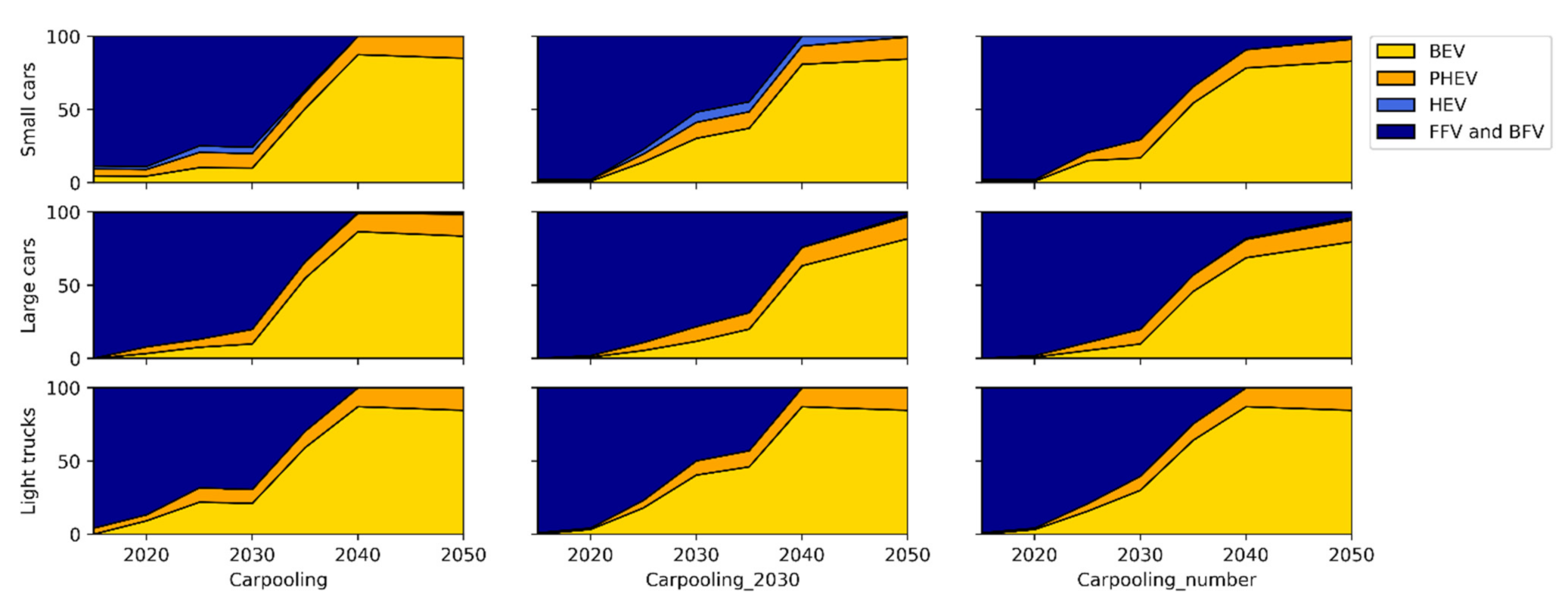
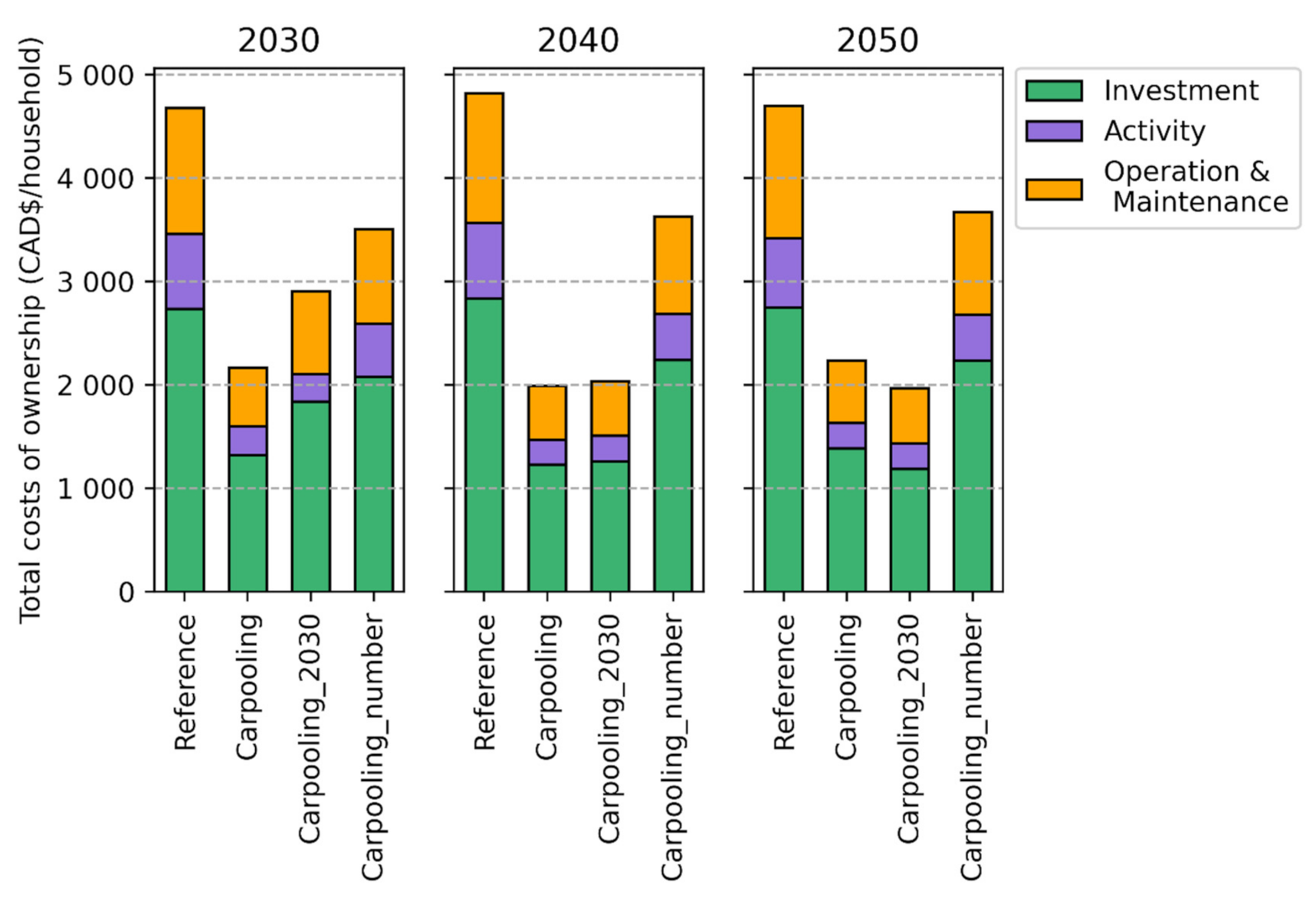
References
- UNFCCC Greenhouse Gas Inventory Data—Time Series—Annex I. Available online: https://di.unfccc.int/time_series (accessed on 11 November 2020).
- Dessens, O.; Anandarajah, G.; Gambhir, A. Limiting global warming to 2 °C: What do the latest mitigation studies tell us about costs, technologies and other impacts? Energy Strateg. Rev. 2016, 13–14, 67–76. [Google Scholar] [CrossRef]
- IPCC. Global warming of 1.5°C. An IPCC Special Report on the Impacts of Global Warming of 1.5 °C above Pre-Industrial Levels and Related Global Greenhouse Gas Emission Pathways, in the Context of Strengthening the Global Response to the Threat of Climate Change; IPCC: Geneva, Switzerland, 2018. [Google Scholar]
- Richter, J.; Friman, M.; Gärling, T. Soft Transport Policy Measures: Gaps in Knowledge. Int. J. Sustain. Transp. 2011, 5, 199–215. [Google Scholar] [CrossRef]
- Venturini, G.; Tattini, J.; Mulholland, E.; Gallachóir, B.Ó. Improvements in the representation of behavior in integrated energy and transport models. Int. J. Sustain. Transp. 2019, 13, 294–313. [Google Scholar] [CrossRef]
- Ramea, K.; Bunch, D.S.; Yang, C.; Yeh, S.; Ogden, J.M. Integration of behavioral effects from vehicle choice models into long-term energy systems optimization models. Energy Econ. 2018, 74, 663–676. [Google Scholar] [CrossRef]
- Karatasou, S.; Laskari, M.; Santamouris, M. Models of behavior change and residential energy use: A review of research directions and findings for behavior-based energy efficiency. Adv. Build. Energy Res. 2014, 8, 137–147. [Google Scholar] [CrossRef]
- McCollum, D.L.; Wilson, C.; Pettifor, H.; Ramea, K.; Krey, V.; Riahi, K.; Bertram, C.; Lin, Z.; Edelenbosch, O.Y.; Fujisawa, S. Improving the behavioral realism of global integrated assessment models: An application to consumers’ vehicle choices. Transp. Res. Part D Transp. Environ. 2017, 55, 322–342. [Google Scholar] [CrossRef]
- Mittal, S.; Dai, H.; Fujimori, S.; Hanaoka, T.; Zhang, R. Key factors influencing the global passenger transport dynamics using the AIM/transport model. Transp. Res. Part D Transp. Environ. 2017, 55, 373–388. [Google Scholar] [CrossRef]
- Pye, S.; Daly, H. Modelling sustainable urban travel in a whole systems energy model. Appl. Energy 2015, 159, 97–107. [Google Scholar] [CrossRef]
- Salvucci, R.; Gargiulo, M.; Karlsson, K. The role of modal shift in decarbonising the Scandinavian transport sector: Applying substitution elasticities in TIMES-Nordic. Appl. Energy 2019, 253, 113593. [Google Scholar] [CrossRef]
- Nikas, A.; Lieu, J.; Sorman, A.; Gambhir, A.; Turhan, E.; Baptista, B.V.; Doukas, H. The desirability of transitions in demand: Incorporating behavioural and societal transformations into energy modelling. Energy Res. Soc. Sci. 2020, 70, 101780. [Google Scholar] [CrossRef]
- Hanna, R.; Gross, R. How do energy systems model and scenario studies explicitly represent socio-economic, political and technological disruption and discontinuity? Implications for policy and practitioners. Energy Policy 2020, 111984. [Google Scholar] [CrossRef]
- Hoffmann, S.; Weyer, J.; Longen, J. Discontinuation of the automobility regime? An integrated approach to multi-level governance. Transp. Res. Part A Policy Pract. 2017, 103, 391–408. [Google Scholar] [CrossRef]
- Arbib, J.; Seba, T. Rethinking Transportation 2020–2030. Available online: https://static1.squarespace.com/static/585c3439be65942f022bbf9b/t/591a2e4be6f2e1c13df930c5/1494888038959/RethinkX+Report_051517.pdf (accessed on 8 February 2018).
- Johnstone, P.; Kivimaa, P. Multiple dimensions of disruption, energy transitions and industrial policy. Energy Res. Soc. Sci. 2018, 37, 260–265. [Google Scholar] [CrossRef]
- Shaheen, S.; Cohen, A.; Bayen, A. The Benefits of Carpooling; UC Berkeley Transportation Sustainability Research Center: Berkeley, CA, USA, 2018. [Google Scholar]
- Sioui, L.; Morency, C.; Trépanier, M. How Carsharing Affects the Travel Behavior of Households: A Case Study of Montréal, Canada. Int. J. Sustain. Transp. 2013, 7, 52–69. [Google Scholar] [CrossRef]
- Woodcock, J.; Edwards, P.; Tonne, C.; Armstrong, B.G.; Ashiru, O.; Banister, D.; Beevers, S.; Chalabi, Z.; Chowdhury, Z.; Cohen, A.; et al. Public health benefits of strategies to reduce greenhouse-gas emissions: Urban land transport. Lancet 2009, 374, 1930–1943. [Google Scholar] [CrossRef]
- Environment and Climate Change Canada National Inventory Report 1990–2018: Greenhouse Gas Sources and Sinks in Canada. Available online: https://www.canada.ca/en/environment-climate-change/services/environmental-indicators/greenhouse-gas-emissions.html (accessed on 13 January 2020).
- Environment and Climate Change Canada Canada’s 4th Biennial Report to the United Nations Framework Convention on Climate Change (UNFCCC). Available online: https://unfccc.int/sites/default/files/resource/Canada’s Fourth Biennial Report on Climate Change 2019.pdf (accessed on 13 January 2020).
- Whitmore, J.; Pineau, P.-O. État de L’énergie au Québec 2019. Available online: http://energie.hec.ca/wp-content/uploads/2018/12/EEQ2019_WEB.pdf (accessed on 10 September 2019).
- Government of Quebec 2030 Plan for a Green Economy. Available online: https://www.quebec.ca/gouv/politiques-orientations/plan-economie-verte/ (accessed on 11 March 2021).
- Ministère des Transports du Québec Propulser le Québec par l’Électricité—Plan d’action d’électrification des Transports 2015–2020. Available online: http://transportselectriques.gouv.qc.ca/wp-content/uploads/CIAO-050-LG2-MTQ-Rapport2016FRv2.1_.pdf (accessed on 16 February 2018).
- Assemblée Nationale du Québec Projet de Loi n°44 : Loi Visant Principalement la Gouvernance Efficace de la Lutte Contre les Changements Climatiques et à Favoriser l’Électrification. Available online: http://www.assnat.qc.ca/fr/travaux-parlementaires/projets-loi/projet-loi-44-42-1.html (accessed on 11 December 2019).
- Newbery, D.; Strbac, G. What is needed for battery electric vehicles to become socially cost competitive? Econ. Transp. 2016, 5, 1–11. [Google Scholar] [CrossRef] [Green Version]
- Vaillancourt, K.; Bahn, O.; Frenette, E.; Sigvaldason, O. Exploring deep decarbonization pathways to 2050 for Canada using an optimization energy model framework. Appl. Energy 2017, 195, 774–785. [Google Scholar] [CrossRef]
- Vaillancourt, K.; Bahn, O.; Roy, P.-O.; Patreau, V. Is there a future for new hydrocarbon projects in a decarbonizing energy system? A case study for Quebec (Canada). Appl. Energy 2018, 218, 114–130. [Google Scholar] [CrossRef]
- Astudillo, M.F.; Vaillancourt, K.; Pineau, P.-O.; Amor, B. Can the household sector reduce global warming mitigation costs? sensitivity to key parameters in a TIMES techno-economic energy model. Appl. Energy 2017, 205, 486–498. [Google Scholar] [CrossRef]
- Loulou, R.; Labriet, M. ETSAP-TIAM: The TIMES integrated assessment model Part I: Model structure. Comput. Manag. Sci. 2008, 5, 7–40. [Google Scholar] [CrossRef]
- Government of Canada Fuel Consumption Ratings—Open Government Portal. Available online: https://open.canada.ca/data/en/dataset/98f1a129-f628-4ce4-b24d-6f16bf24dd64 (accessed on 11 September 2019).
- Natural Resources Canada 2019 Fuel Consumption Guide. Available online: https://www.nrcan.gc.ca/sites/www.nrcan.gc.ca/files/oee/pdf/transportation/tools/fuelratings/2019 Fuel Consumption Guide.pdf (accessed on 11 September 2019).
- Natural Resources Canada Comprehensive Energy Use Database. Available online: http://oee.nrcan.gc.ca/corporate/statistics/neud/dpa/menus/trends/comprehensive_tables/list.cfm (accessed on 30 August 2019).
- Association Canadienne des Automobilistes Coûts d’Utilisation d’une Automobile Au-delà de l’Étiquette de Prix : Comprendre les Dépenses Liées au Véhicule. Available online: http://caa.ca/car_costs/fr (accessed on 30 August 2019).
- Roulons électrique. Choisir un Véhicule Rechargeable qui Répond à vos Besoins; Roulons Électrique: Montreal, QC, Canada, 2019. [Google Scholar]
- Desjardins Perspective: Les Québécois et leur Automobile: Des Liens Tissés Serrés. Available online: www.desjardins.com/economie (accessed on 30 July 2019).
- Jadun, P.; McMillan, C.; Steinberg, D.; Muratori, M.; Vimmerstedt, L.; Mai, T. Electrification Futures Study: End-Use Electric Technology Cost and Performance Projections through 2050. Available online: www.nrel.gov/publications. (accessed on 19 July 2018).
- Environment and Climate Change Canada. Technical Paper on the Federal Carbon Pricing Backstop. Available online: https://www.canada.ca/en/services/environment/weather/climatechange/technical-paper-federal-carbon-pricing-backstop.html (accessed on 15 January 2018).
- Environment and Climate Change Canada. A Brief Look at the Quebec Cap-and-Trade System for Emission Allowances. Available online: https://www.environnement.gouv.qc.ca/changements/carbone/documents-spede/in-brief.pdf (accessed on 1 January 2013).
- Government of Canada Renewable Fuels Regulations. Available online: https://pollution-waste.canada.ca/environmental-protection-registry/regulations/view?Id=103 (accessed on 30 August 2019).
- Ministère de l’Environnement et de la Lutte Contre les Changements Climatiques Le Système Québécois de Plafonnement et d’Échange de Droit d’Émission en Bref. Available online: http://www.environnement.gouv.qc.ca/changements/carbone/documents-spede/en-bref.pdf (accessed on 16 September 2019).
- Under2coalition the under 2 MOU. Available online: https://www.under2coalition.org/under2-mou (accessed on 11 December 2019).
- Ministère de l’Environnement et de la Lutte Contre les Changements Climatiques Quebec’s Commitments: Our GHG Emissions Reduction Targets. Available online: http://www.environnement.gouv.qc.ca/changementsclimatiques/engagement-quebec-en.asp (accessed on 11 December 2019).
- Poirier, M.; Vaillancourt, K.; Joly, E. Trajectoires de Réduction d’Émissions de GES du Québec—Horizons 2030 et 2050. Available online: https://www.environnement.gouv.qc.ca/changementsclimatiques/trajectoires-emissions-ges.pdf (accessed on 30 June 2019).
- Transport Canada Transportation in Canada 2017—Statistical addendum. Environment 2018, 1–155.
- Available online: https://www.sciencedirect.com/science/article/abs/pii/S0301421520306959 (accessed on 28 February 2021).
- Wang, C.; Daziano, R.A. On the problem of measuring discount rates in intertemporal transportation choices. Transportation 2015, 42, 1019–1038. [Google Scholar] [CrossRef]
- Haq, G.; Weiss, M. Time preference and consumer discount rates—Insights for accelerating the adoption of efficient energy and transport technologies. Technol. Forecast. Soc. Chang. 2018, 137, 76–88. [Google Scholar] [CrossRef]
- US Department of Transportation Highway Statistics Series—Policy|Federal Highway Administration. Available online: https://www.fhwa.dot.gov/policyinformation/statistics.cfm (accessed on 9 May 2021).
- Pye, S.; Broad, O.; Bataille, C.; Brockway, P.; Daly, H.E.; Freeman, R.; Gambhir, A.; Geden, O.; Rogan, F.; Sanghvi, S.; et al. Modelling net-zero emissions energy systems requires a change in approach. Clim. Policy 2021, 21, 222–231. [Google Scholar] [CrossRef]
- Société de l’Assurance Automobile du Québec Bilan 2018: Accidents, Parc Automobile et Permis de Conduire. Available online: https://saaq.gouv.qc.ca/fileadmin/documents/publications/espace-recherche/dossier-statistique-bilan-2018.pdf (accessed on 11 December 2019).
- Mai, T.; Jadun, P.; Logan, J.; Mcmillan, C.; Muratori, M.; Steinberg, D.; Vimmerstedt, L.; Jones, R.; Haley, B.; Nelson, B. Electrification Futures Study: Scenarios of Electric Technology Adoption and Power Consumption for the United States. Available online: https://www.nrel.gov/docs/fy18osti/71500.pdf (accessed on 30 June 2018).
- Seixas, J.; Simões, S.; Dias, L.; Kanudia, A.; Fortes, P.; Gargiulo, M. Assessing the cost-effectiveness of electric vehicles in European countries using integrated modeling. Energy Policy 2015, 80, 165–176. [Google Scholar] [CrossRef]
- Hydro-Québec Distribution Romaine Complex. Available online: https://www.hydroquebec.com/projects/romaine.html (accessed on 16 September 2019).
- Mulholland, E.; Tattini, J.; Ramea, K.; Yang, C.; Ó Gallachóir, B.P. The cost of electrifying private transport—Evidence from an empirical consumer choice model of Ireland and Denmark. Transp. Res. Part D Transp. Environ. 2018, 62, 584–603. [Google Scholar] [CrossRef]
- Palmer, K.; Tate, J.E.; Wadud, Z.; Nellthorp, J. Total cost of ownership and market share for hybrid and electric vehicles in the UK, US and Japan. Appl. Energy 2018, 209, 108–119. [Google Scholar] [CrossRef]
- Canada Energy Regulator Market Snapshot: Levelized Costs of Driving EVs and Conventional Vehicles. Available online: https://www.cer-rec.gc.ca/nrg/ntgrtd/mrkt/snpsht/2019/06-01lvlzdcstsdrvng-eng.html (accessed on 16 September 2019).
- Association des Véhicules Électriques du Québec Véhicules Actuellement Disponibles 2019. Available online: https://www.aveq.ca/actualiteacutes/category/statistiques (accessed on 9 June 2020).
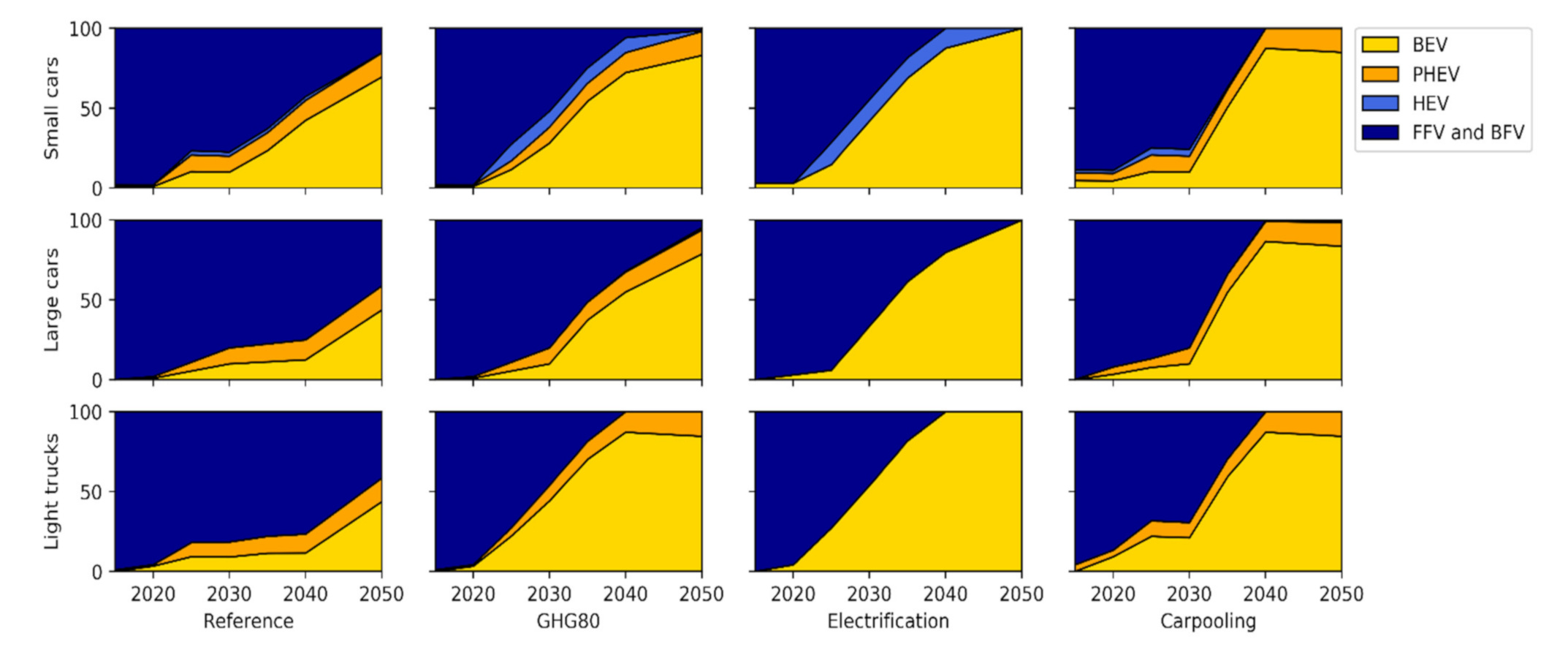
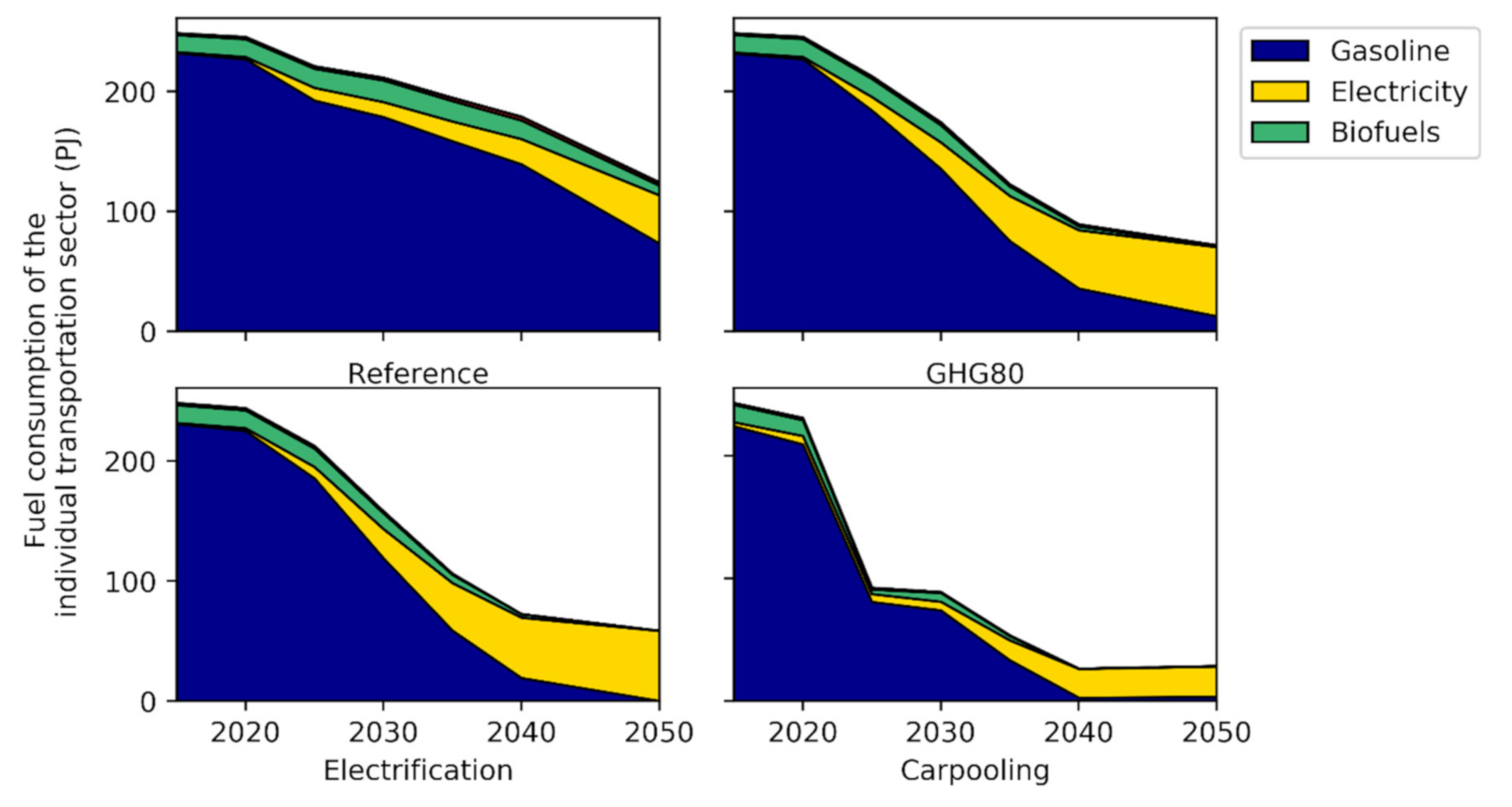
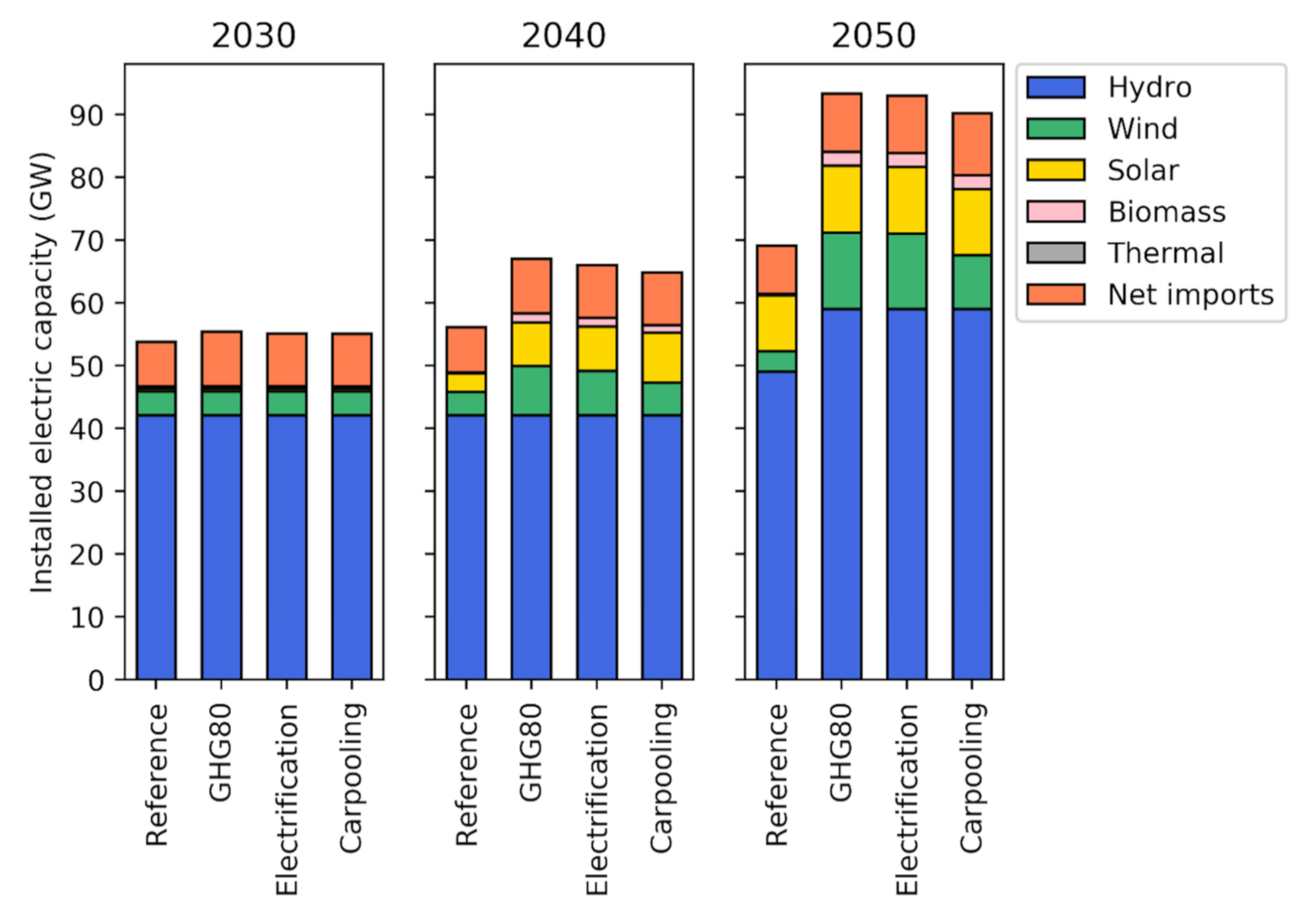



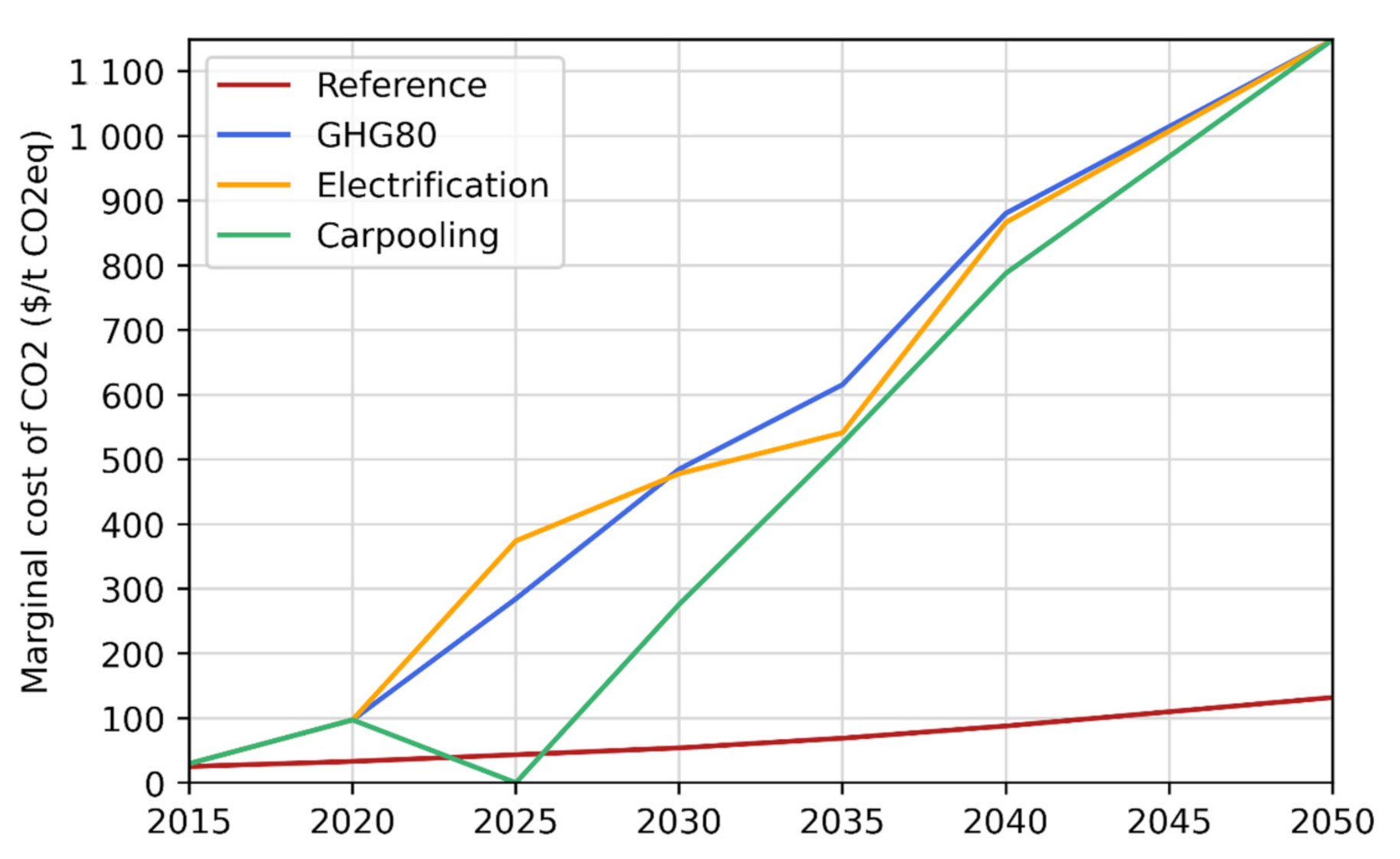

| Year | Reduction (Compared to 1990) | Emissions (Mt CO2eq) |
|---|---|---|
| 1990 | - | 86.5 |
| 2030 | −37.5% | 52.9 |
| 2050 | −80% | 16.9 |
| Vehicle Class | 2025 | 2030 | 2050 |
|---|---|---|---|
| Small cars 1 | 6.0% | 31.0% | 100% |
| Large cars 1 | 6.0% | 31.0% | 100% |
| Light trucks 1 | 9.4% | 46.9% | 100% |
| Distance (Km) | Number of Passengers per Vehicle (Carpooling Scenario) | 2017 Number of Passengers per Vehicle | Total Demand (%) | Shift in Demand (%) |
|---|---|---|---|---|
| <1 | n.a. (individual cars are not used) | 1.2 | 23.6 | −20.0 |
| 1–11 | 3.0 | 1.5 | 53.1 | −26.6 |
| 12–50 | 3.6 | 1.6 | 20.2 | −10.1 |
| 51–100 | 3.6 | 1.8 | 2.2 | −1.1 |
| >100 | 3.6 | 2.1 | 1.1 | −0.44 |
Publisher’s Note: MDPI stays neutral with regard to jurisdictional claims in published maps and institutional affiliations. |
© 2021 by the authors. Licensee MDPI, Basel, Switzerland. This article is an open access article distributed under the terms and conditions of the Creative Commons Attribution (CC BY) license (https://creativecommons.org/licenses/by/4.0/).
Share and Cite
Pedinotti-Castelle, M.; Pineau, P.-O.; Vaillancourt, K.; Amor, B. Changing Technology or Behavior? The Impacts of a Behavioral Disruption. Sustainability 2021, 13, 5861. https://doi.org/10.3390/su13115861
Pedinotti-Castelle M, Pineau P-O, Vaillancourt K, Amor B. Changing Technology or Behavior? The Impacts of a Behavioral Disruption. Sustainability. 2021; 13(11):5861. https://doi.org/10.3390/su13115861
Chicago/Turabian StylePedinotti-Castelle, Marianne, Pierre-Olivier Pineau, Kathleen Vaillancourt, and Ben Amor. 2021. "Changing Technology or Behavior? The Impacts of a Behavioral Disruption" Sustainability 13, no. 11: 5861. https://doi.org/10.3390/su13115861
APA StylePedinotti-Castelle, M., Pineau, P.-O., Vaillancourt, K., & Amor, B. (2021). Changing Technology or Behavior? The Impacts of a Behavioral Disruption. Sustainability, 13(11), 5861. https://doi.org/10.3390/su13115861







